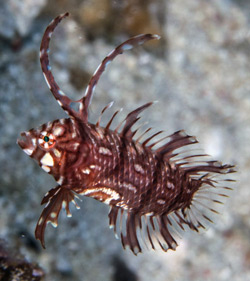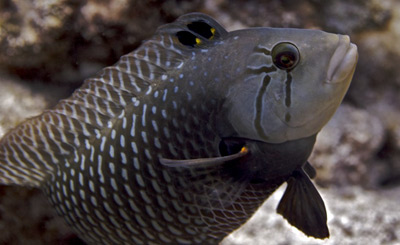In a previous post titled “Marine Fish Bait and Switch—5 Adorable Juveniles that Blossom into Brutes,” I listed the rockmover wrasse (Novaculichthys taeniourus), aka the reindeer wrasse or the dragon wrasse, among four other species that are typically sold in the marine aquarium trade as cute little youngsters but mature into very different adults. However, despite its surprising (for those who didn’t do their advance research) transformation, I think N. taeniourus remains a worthy aquarium species provided certain accommodations are made.
That notorious physical transformation
Depending on where they’re collected, the juveniles (the stage at which they’re typically sold), are either green or burgundy with dark brown and white mottling. Their color and patterning allow them to camouflage among growths of algae. They also possess two greatly elongated dorsal spines that vaguely resemble a deer’s antlers, giving rise to the “reindeer wrasse” moniker. Perhaps not surprisingly, owing to their cuteness, juveniles often tempt unwary hobbyists into an ill-considered purchase.

In adults, those elongated dorsal spines disappear and the mottling gives way to an alternating light and dark coloration of the scales and a somewhat vermiculated pattern on the unpaired fins. The head is light gray with dark lines radiating backward from the eyes, and a broad vertical band appears on the tail. Maximum length is around a foot.
Some hobbyists might argue that the adults aren’t as attractive as the juveniles, but I disagree. In fact, to my eye, the adults are quite striking.
That notorious behavioral transformation
While the juveniles are generally docile and suitable for community aquariums not housing any species likely to bully them, it’s important to be aware that the adults have a very different disposition. I guess you could say the bullied becomes the bully. So, tankmates must be chosen with care.
Feeding
In nature, rockmover wrasses feed on a wide variety of motile invertebrates, which they expose by overturning pieces of rubble around the base of the reef. Captive specimens should be offered meaty food items, such as mysids, blackworms, frozen carnivore formulations and chopped crustacean, mollusk, or fish flesh, several times per day.
Housing
Here’s an area where certain accommodations must be made in order to keep this species successfully:
- First, this is a fairly sizeable fish that needs commensurate living space. A tank in the vicinity of 125 gallons is a good target.
- Second, this wrasse does bury at night, so it needs a sand bed that’s several inches in depth.
- Third, it comes by the name “rockmover” honestly, so you do have to ensure the rockwork is well secured. I’m not saying this fish is going to flip boulders, but it could upset an unstable pile with its foraging behavior.
- Fourth, like any respectable wrasse, N. taeniourus is a notorious jumper, so the tank must be well covered.
Compatibility
Again, the rockmover wrasse can get aggressive, so any tankmates must be fairly rough-and-tumble characters themselves. Potential choices include larger angels, community-appropriate triggers, larger surgeons, and the like. Keep only one specimen to a tank.
I would not recommend keeping this species in a reef system. Not only is N. taeniourus too big and messy to be suitable for most reef systems, but that rubble-flipping behavior can also be directed toward coral specimens, which certainly won’t do them (the corals that is) any good.



